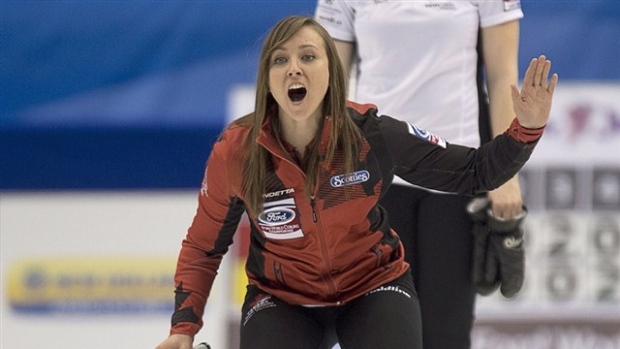Jan 7, 2015
Continental Cup of Curling continues reinvention on return to Canada
After the showgirls and the Thunder From Down Under, what's next for the Continental Cup of Curling? What's been dubbed "the Ryder Cup of curling" was held in Las Vegas a year ago.
The Canadian Press

CALGARY - After the showgirls and the Thunder From Down Under, what's next for the Continental Cup of Curling?
What's been dubbed "the Ryder Cup of curling" was held in Las Vegas a year ago.
Bagpipes played as curlers walked through a casino. Muscular bare-chested dancers from an all-male revue led them onto the playing surface holding placards of the team names. Bikini-clad showgirls held up scores for shots in the skills competition.
The World Financial Group Continental Cup has returned to Canada where it was held its first nine years before the getaway to Vegas. The four-day competition of team, mixed doubles, hot-shots and skins games starts Thursday at the 3,000-seat Markin MacPhail Centre at Canada Olympic Park.
The Continental Cup may be back in Canada, but experimentation with it is far from over.
The Canadian Curling Association has taken over complete control of the event. Team Europe will face Team Canada, not Team North America, in Calgary.
A total of 60 points are available, so the side that earns more than 30 points by Sunday is the champion.
Olympic champions Jennifer Jones of Winnipeg and Brad Jacobs of Sault Ste. Marie, Ont., lead a Canadian contingent including teams skipped by world silver medallist Rachel Homan of Ottawa, Calgary's John Morris, Winnipeg's Mike McEwen and Edmonton's Val Sweeting.
Every team who stood on the Olympic podium in Sochi, Russia, last year will be in Calgary: silver medallists David Murdoch of Scotland and Margaretha Sigfridsson of Sweden along with bronze-medallists Niklas Edin of Sweden and Eve Muirhead of Scotland.
Reigning world men's champion Thomas Ulsrud of Norway and world bronze medallist Anna Sidorova of Russia round out Team Europe, whose record is 4-6 over the history of the event.
Canadians and Americans previously joined forces under a Team North America banner, but the tournament's backers have shifted priorities.
According to a World Curling Federation report, the world governing body for the sport decided after spending about $2 million on team costs, prize money and "share of losses" over the first decade of the Continental Cup, it no longer wanted to be involved.
"Unfortunately it has not really caught on beyond the North American TV market," the WCF said in the report posted on its website.
"The WCF executive board agreed that it was no longer justifiable for the WCF to spend the levels it had been over the past few years to maintain this event."
USA Curling didn't have a financial stake in the event, although it paid American teams' expenses, according to spokesperson Terry Kolesar.
"We were not invited to participate in the 2015 Continental Cup in Calgary," she told The Canadian Press in an e-mail Wednesday.
The CCA announced last month that ESPN acquired the U.S. rights to its Season of Champions events, including the Continental Cup, to be shown on ESPN3.
But for now, what is a made-for-TV sports event will be a made-for-Canadian-TV sports event.
"Increasing the Canadian content was also important to our sponsors and to television," CCA chief executive officer Greg Stremlaw said. "They asked us to try and increase Canadian content and that's what we've done."
The Continental Cup's reinvention isn't over. Stremlaw indicated other countries may be invited to future tournaments and that announcement will be made at a news conference Friday.
"That may have further benefits to the U.S. and other countries who have never competed at the Continental Cup before," he said. "We're going to try and involve other countries."
The Continental Cup showcases curling's stars in a way that is novel for the curlers and unique for those watching at home. The 2014 Continental Cup drew an average of 300,000 viewers compared to a prime-time average of 188,000 in 2008, according to TSN.
The athletes take the event seriously, but not as seriously as a national or world championships. There's more whooping and trash-talking not to mention more socializing away from the ice.
Ulsrud took advantage of the Americans' absence to throw an early barb at Canadians.
"It's going to be even sweeter beating you guys because you always blame the U.S. if you lose," he quipped.
The modest stakes — $2,000 per curler on the winning side and $1,000 per loser — contribute to the let-your-hair-down atmosphere. A bonus $500 per curler goes to the team with the highest point total from the six skins games.
Jacobs third Ryan Fry feels this year's format more closely mirrors golf's Ryder Cup, which pits the U.S. against Europe.
"Canada is still the dominant country when it comes to curling," Fry said. "It's other countries' jobs to compete against us to try and take that title away from us. This is one of the events that allows that."
The Continental Cup is also a low-risk venue for the CCA to try out new elements. There will be ice-level LED boards running the length of the arena — like those seen in CFL games — for advertising and promotions.
Another test for the CCA this winter is holding the Continental Cup of Curling and the Tim Hortons Brier in the same season and city for the first time. The Canadian men's championship is Feb. 28-March 8 at the Scotiabank Saddledome.
"Having two events in one location is something we haven't done before in terms of those two significant event," Stremlaw said. "We thought with two different events, in the same market, of all the cities that could pull that off Calgary was a great place to try and actually do that."
